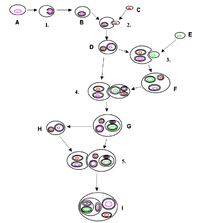
An endosymbiont or endobiont[1] is an organism that lives within the body or cells of another organism. Typically the two organisms are in a mutualistic relationship. Examples are nitrogen-fixing bacteria (called rhizobia), which live in the root nodules of legumes, single-cell algae inside reef-building corals, and bacterial endosymbionts that provide essential nutrients to insects.[2][3]
Endosymbiosis played key roles in the development of eukaryotes and plants. Roughly 2.2 billion years ago an archaeon absorbed a bacterium through phagocytosis, that eventually became the mitochondria that provide energy to almost all living eukaryotic cells. Approximately 1 billion years ago, some of those cells absorbed cyanobacteria that eventually became chloroplasts, organelles that produce energy from sunlight.[4] Approximately 100 million years ago, a lineage of amoeba in the genus Paulinella independently engulfed a cyanobacteria that evolved to be functionally synonymous with traditional chloroplasts, called chromatophores.[5]
Some 100 million years ago, UCYN-A, a nitrogen-fixing bacterium, became an endosymbiont of the marine alga Braarudosphaera bigelowii, eventually evolving into a nitroplast, which fixes nitrogen.[6] Similarly, diatoms in the family Rhopalodiaceae have cyanobacterial endosymbionts, called spheroid bodies or diazoplasts, which have been proposed to be in the early stages of organelle evolution.[7][8]
Symbionts are either obligate (require their host to survive) or facultative (can survive independently).[9] The most common examples of obligate endosymbiosis are mitochondria and chloroplasts, which reproduce via mitosis in tandem with their host cells. Some human parasites, e.g. Wuchereria bancrofti and Mansonella perstans, thrive in their intermediate insect hosts because of an obligate endosymbiosis with Wolbachia spp.[10] They can both be eliminated by treatments that target their bacterial host.[11]
- ^ Margulis L, Chapman MJ (2009). Kingdoms & domains an illustrated guide to the phyla of life on Earth (4th ed.). Amsterdam: Academic Press/Elsevier. p. 493. ISBN 978-0-08-092014-6.
- ^ Mergaert P (April 2018). "Role of antimicrobial peptides in controlling symbiotic bacterial populations". Natural Product Reports. 35 (4): 336–356. doi:10.1039/c7np00056a. PMID 29393944.
- ^ Little AF, van Oppen MJ, Willis BL (June 2004). "Flexibility in algal endosymbioses shapes growth in reef corals". Science. 304 (5676): 1492–1494. Bibcode:2004Sci...304.1491L. doi:10.1126/science.1095733. PMID 15178799. S2CID 10050417.
- ^ Baisas, Laura (18 April 2024). "For the first time in one billion years, two lifeforms truly merged into one organism". Popular Science. Retrieved 26 April 2024.
- ^ Macorano, Luis; Nowack, Eva C.M. (13 September 2021). "Paulinella chromatophora". Current Biology. 31 (17): R1024–R1026. doi:10.1016/j.cub.2021.07.028. ISSN 0960-9822.
- ^ Wong, Carissa (11 April 2024). "Scientists discover first algae that can fix nitrogen — thanks to a tiny cell structure". Nature. 628 (8009). Nature.com: 702. Bibcode:2024Natur.628..702W. doi:10.1038/d41586-024-01046-z. PMID 38605201. Archived from the original on 14 April 2024. Retrieved 16 April 2024.
- ^ Nakayama, T.; Inagaki, Y. (2017). "Genomic divergence within non-photosynthetic cyanobacterial endosymbionts in rhopalodiacean diatoms". Scientific Reports. 7 (1): 13075. Bibcode:2017NatSR...713075N. doi:10.1038/s41598-017-13578-8. PMC 5638926. PMID 29026213.
- ^ Schvarcz, Christopher R.; Wilson, Samuel T.; Caffin, Mathieu; Stancheva, Rosalina; Li, Qian; Turk-Kubo, Kendra A.; White, Angelicque E.; Karl, David M.; Zehr, Jonathan P.; Steward, Grieg F. (10 February 2022). "Overlooked and widespread pennate diatom-diazotroph symbioses in the sea". Nature Communications. 13 (1): 799. doi:10.1038/s41467-022-28065-6. ISSN 2041-1723. PMC 8831587. PMID 35145076.
- ^ Bright, Monika; Bulgheresi, Silvia (March 2010). "A complex journey: transmission of microbial symbionts". Nature Reviews Microbiology. 8 (3): 218–230. doi:10.1038/nrmicro2262. ISSN 1740-1534. PMC 2967712. PMID 20157340.
- ^ Slatko, Barton E.; Taylor, Mark J.; Foster, Jeremy M. (1 July 2010). "The Wolbachia endosymbiont as an anti-filarial nematode target". Symbiosis. 51 (1): 55–65. Bibcode:2010Symbi..51...55S. doi:10.1007/s13199-010-0067-1. ISSN 1878-7665. PMC 2918796. PMID 20730111.
- ^ Warrell D, Cox TM, Firth J, Török E (11 October 2012). Oxford Textbook of Medicine: Infection. OUP Oxford. ISBN 978-0-19-965213-6.